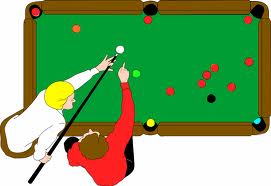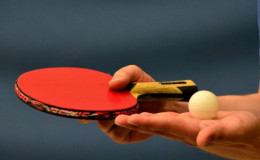
- Snooker is a sport that is played on a large green baize-covered table with pockets in each of the four corners.
- It is played using a cue and snooker balls
- A player (or team) wins a frame (individual game) of snooker by scoring more points than the opponent(s), using the cue ball to pot the red and coloured balls.
- A player wins a match when a certain number of frames have been won.
Table size:
- A regular (full-size) table is 12 × 6 ft (3.7 × 1.8 m).
- The variants in table size are: 10'' x 5'', 9'' x 4.5'', 8'' x 4'', 6'' x 3'' (the smallest for realistic play) and 4'' x 2''
- Smaller tables can come in a variety of styles, such as fold away or dining-table convertible.
- Drawback of snooker on a full-size table is the size of the room (22'' x 16'' or approximately 5 m x 7 m), which is the minimum required for comfortable cueing room on all sides.
Cue / snooker stick:
- It is used to strike a ball, usually the cue ball.
- Cues are conical sticks, typically about 58 inches (1.5 m) long and 18–21 ounces (510–600 g).
- Most cues are made of wood, but occasionally the wood is covered or bonded with other materials including, graphite, carbon fibre or fibreglass.
- Snooker balls:
- No standard weight is defined, but all balls in the set must be the same weight within a tolerance of 3 gm.
- Snooker balls are technically standardized at 52.5 mm in diameter within a tolerance of plus or minus 0.05 mm (0.002 in.)
- There is one white cue ball, 15 red balls worth one point each. And six balls of different colours with different points yellow (2 points), green (3points), brown (4points), blue (5points), pink (6points) and black (7).
Rules of snooker:
The object of the game is to score more points than the opponent by potting object balls in a predefined order.
At the start of a frame, the balls are positioned and the players take it in turns to hit a shot in a single strike from the tip of the cue, their aim being to pot one of the red balls and score a point.
If they do pot at least one red, then it remains in the pocket and they are allowed another shot
If successful, then they gain the value of the colour potted. It is returned to its correct position on the table and they must try to pot another red. This process continues until one player fail to pot the desired ball.
- The game continues until all the reds are potted and only the 6 colours are left on the table.
Then the aim is to pot the colours in the order yellow 2, green 3, brown 4, blue 5, pink 6, and black 7.
When a colour is potted in this phase of a frame, it remains off the table. When the final ball is potted, the player with the most points wins.
*(In one game, from the balls in their starting position until the last ball is potted, is called a frame)
A match generally consists of a predefined number of frames and the player who wins the most frames wins the match overall. Most professional matches require a player to win five frames, and are called ''Best of Nine'' (maximum number of frame).
Referee:
Professional and competitive amateur matches are officiated by a referee who is the sole judge of fair play.
The referee is also responsible for reposting the colours on to the table and calls out how many points the player has scored during a break.
Fouls
A point can also be gained when opponents makes a foul.
A foul can occur for numerous reasons, such as hitting a colour first when the player was attempting to hit a red, potting the cue ball, or failing to escape from "a snooker”
*Failing to escape from "a snooker" (a situation where the previous player finished their turn leaving the cue ball in a position where the object ball cannot be hit directly).
Points gained from a foul vary from a minimum of 4 to a maximum of 7 if the black ball is involved.
Governance
- The World Professional Billiards and Snooker Association is the governing body for the professional game.
- The amateur game is governed by the International Billiards and Snooker Federation (IBSF)
Main Tournaments
- World Championship.
- UK Championship.
- The Masters.
- Premier League Snooker.
Equipments:
- Chalk-The tip of the cue is ''chalked'' to ensure good contact between the cue and the cue-ball.
- Cue-A stick, made of wood or fibreglass, the tip of which is used to strike the cue-ball.
- Rest -A stick with an X-shaped head that is used to support the cue when the cue ball is out of reach at normal extension.
- Rest head adaptor-An attachment that slips onto a conventional rest head to make a spider or just to give a slightly different bridge
- Hook rest - Identical to the normal rest, yet with a hooked metal end. It is used to set the rest around another ball. The hook rest is the most recent invention in snooker.
- Spider-Similar to the rest but with an arch-shaped head; it is used to elevate and support the tip of the cue above the height of the cue-ball.
- Swan -(or swan-neck spider)This equipment, consisting of a rest with a single extended neck and a fork-like prong at the end, is used to give extra cueing distance over a group of balls and others.










